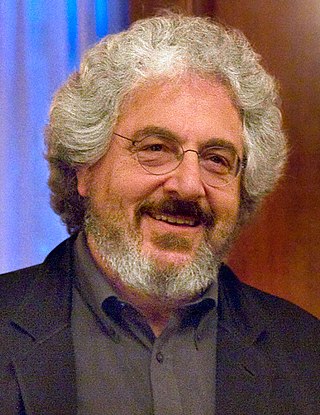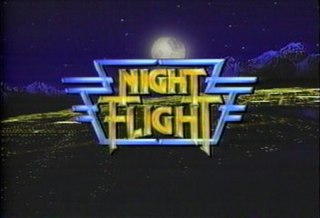New wave is a music genre that encompasses pop-oriented styles from the 1970s through the 1980s. It is considered a lighter and more melodic "broadening of punk culture". It was originally used as a catch-all for the various styles of music that emerged after punk rock. Later, critical consensus favored "new wave" as an umbrella term involving many contemporary popular music styles, including synth-pop, alternative dance and post-punk. The main new wave movement coincided with late 1970s punk and continued into the early 1980s.
A music video is a video that integrates a song or an album with imagery that is produced for promotional or musical artistic purposes. Modern music videos are primarily made and used as a music marketing device intended to promote the sale of music recordings. These videos are typically shown on music television and on streaming video sites like YouTube, or more rarely shown theatrically. They can be commercially issued on home video, either as video albums or video singles. The format has been described by various terms including "illustrated song", "filmed insert", "promotional (promo) film", "promotional clip", "promotional video", "song video", "song clip", "film clip", "video clip", or simply "video".

The Cars were an American rock band formed in Boston in 1976. Emerging from the new wave scene in the late 1970s, they consisted of Ric Ocasek, Benjamin Orr, Elliot Easton, Greg Hawkes (keyboards), and David Robinson (drums). Ocasek and Orr shared lead vocals, and Ocasek was the band's principal songwriter and leader.

The Tubes are a San Francisco-based rock band. Their self-titled 1975 debut album included the single "White Punks on Dope", while their 1983 single "She's a Beauty" was a top-10 U.S. hit and its music video was frequently played in the early days of MTV. The band also performed in the 1980 film Xanadu, singing the rock portion of the cross-genre song "Dancin'" opposite a big band.

Harold Allen Ramis was an American actor, comedian, and filmmaker. His film acting roles include Egon Spengler in Ghostbusters (1984) and Ghostbusters II (1989), and as Russell Ziskey in Stripes (1981); he also co-wrote those films. As a director, his films include the comedies Caddyshack (1980), National Lampoon's Vacation (1983), Groundhog Day (1993), Analyze This (1999) and Analyze That (2002). Ramis was the original head writer of the television series SCTV, on which he also performed, as well as a co-writer of Groundhog Day and National Lampoon's Animal House (1978). The final film that he wrote, produced, directed, and acted in was Year One (2009).

CBGB was a New York City music club opened in 1973 by Hilly Kristal in the East Village in Manhattan, New York City. The club was previously a biker bar and before that was a dive bar. The letters CBGB were for Country, Bluegrass, Blues, Kristal's original vision for the club. But CBGB soon emerged as a famed and iconic venue for punk rock and new wave bands, including the Ramones, Dead Boys, Television, Patti Smith Group, Blondie, Madonna and Talking Heads.

Countdown was a weekly Australian music television program that was broadcast by the Australian Broadcasting Corporation from 8 November 1974 until 19 July 1987. It was created by Executive Producer Michael Shrimpton, producer/director Robbie Weekes and record producer and music journalist Ian "Molly" Meldrum. Countdown was produced at the studios of the ABC in the Melbourne suburb of Ripponlea. It was screened Sunday night from 6:00pm to 7:00.

Cassandra Gay Peterson is an American actress best known for her portrayal of the horror hostess character Elvira, Mistress of the Dark. Peterson gained fame on Los Angeles television station KHJ-TV in her stage persona as Elvira, hosting Elvira's Movie Macabre, a weekly B movie presentation. A member of the Los Angeles-based improvisational and sketch comedy troupe The Groundlings, Peterson based her Elvira persona in part on a "Valley girl"-type character she created while a member of the troupe.

New Traditionalists is the fourth studio album by the American new wave band Devo, released in 1981 by Warner Bros. Records. The album was recorded over a period of four months between December 1980 and April 1981 at the Power Station in Manhattan, New York City. It features the minor hits "Through Being Cool" and "Beautiful World".
Liquid Liquid is an American no wave and dance-punk group, originally active from 1980 to 1983. They are best known for their track "Cavern," which was covered—without proper permission or attribution—by the Sugar Hill Records house band as the backing track for Melle Mel's old school rap classic "White Lines ." The group released a series of extended plays, including the acclaimed 1983 12" EP Optimo. In 2008, the band reformed and have played in multiple countries.
Richard Blade is a British-American Los Angeles–based radio, television, and film personality from Torquay, England. He is best known for his radio programs that feature new wave and popular music from the 1980s. He was a disc jockey at KROQ in Los Angeles from 1982 to 2000 and has been a host for SiriusXM's 1st Wave classic alternative station since 2005.

Night Flight is an online visual-arts magazine and variety television show that originated on cable TV network USA Network. It originally aired from 1981 to 1988 before moving to syndication in the early 1990s. The show relaunched online on nightflight.com in 2015 with original episodes that can be streamed on the subscription channel Night Flight Plus. In April 2018, it returned to cable television as a short form (15-minute) program airing late Friday nights/early Saturday mornings on the network IFC. It includes a mix of mainstream and alternative music videos, artist interviews, B movies, documentaries, short films, stand-up comedy and animation.

Peter Scott Ivers was an American musician, singer, songwriter, and television personality. He was the host of the experimental music television show New Wave Theatre. Despite Ivers never having achieved mainstream success, biographer Josh Frank has described him as being connected by "a second degree to every major pop culture event of the last 30 years."
David Jove, born David Sniderman, was a Canadian director, producer, and writer, particularly of underground and alternative music-themed films.

Avalon is a historic nightclub in Hollywood, California, located near the intersection of Hollywood and Vine, at 1735 N. Vine Street. It has previously been known as The Hollywood Playhouse, The WPA Federal Theatre, El Capitan Theatre, The Jerry Lewis Theatre, The Hollywood Palace and The Palace. It has a capacity of 1,500, and is located across the street from the Capitol Records Building.
The History of Rock & Roll is an American radio documentary on rock and roll music, first syndicated in 1969. Originally one of the lengthiest documentaries of any medium, The History of Rock & Roll is a definitive history of the Rock and Roll genre, stretching from the early 1950s to the present day. The "rockumentary," as producers Bill Drake and Gene Chenault called it, features hundreds of interviews and comments from numerous rock artists and people involved with rock and roll.

Elvira's Movie Macabre, or simply Movie Macabre, is an American hosted horror movie television program that originally aired locally from 1981 to 1986. The show features B movies, particularly those in the horror and science fiction genres, and is hosted by Elvira, a character with a black dress and heaven bump hairstyle, played by Cassandra Peterson. Elvira occasionally interrupts the films with comments and jokes, and in some episodes receives phone calls from a character called "the Breather".
Chiller Theatre was a Saturday night television series broadcast by Channel 11 WPIX in New York City that showed classic horror movies.

New Order 316 is a live DVD released by New Order, in 2001 by Warner Music Vision and London Records. It consists of two concerts. The first took place on 18 November 1981 at the Ukrainian National Home in the East Village of New York City, and features 9 tracks. The second took place at the Reading Festival on 30 August 1998, and features 11 tracks. The DVD title is derived from the combined set list of 3 Joy Division and 16 New Order tracks.

Bruno Verner is a Brazilian composer, poet, electronic musician, performance artist and compiler, best known for his work as the other half of Brazilian tropical punk funk duo Tetine which he formed with Eliete Mejorado in São Paulo in 1995.













